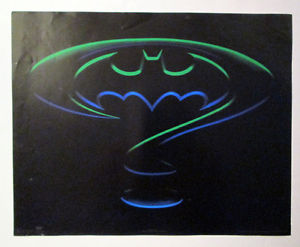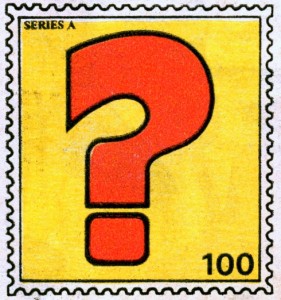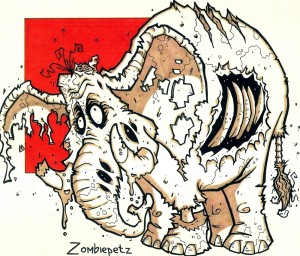So, it’s a few weeks into the new year. Christmas trees are being recycled, merchandise is being discounted, and resolutions are being retconned. That means I’d better get my ruminations done.
What happened in 2013?
A lot.
Hoo boy, was there all sorts of stuff going on! Some of it which would have been major headlines a decade ago (like that superhero documentary on PBS!) but which barely registered a blip. Amazing books, some of which charted but weren’t noticed, some of which quietly made their ways into bookstores and libraries without comics fans noticing.
I truly believe that in historical retrospection, 2013 will be a landmark year, as significant, if not more so, than 1986. Amazing books. Comics publishers pushing diversity through every possible method (digital! television interviews! movies! social media!), with a variety of business models. What once was traditional has become quaint. Sure, the old ways still work, but there are so many new ways of doing things, so much experimentation occurring all over the place, it’s like I just want to relax on my front porch, watch the Mardi Gras parade go by, and grab a few beads!
What was the most significant aspect of comics in 2013?
I picked the massive growth of comic conventions and shows, way back in June.
TCAF was/is bursting at the seams.
Calgary sold out before the show opened.
Salt Lake City, hosting an inaugural event, drew 70,000. attendees (without a Sunday on the schedule!)
When NYCC rolled around, I guess-timated an increase from 106 to 120 thousand.
Final tally? 133,000!
Why the influx?
That goes back to the mainstreaming of the medium, which has been slowly happening since Pokemon saved the comics industry back in 1998.
No longer are comics the “weird kids” at the far end of the school with their popcorn and movies on Friday. Instead, we are the cool kids hanging out by the tennis court, with our Hollywood blockbusters and must-see TV.
Every movie and TV show is a commercial for comics. (Which DC proved quite effectively in the Summer of 2008.)
We saw this on the bestseller lists, where The Walking Dead was the #1 title this year, charting even when the show was not airing, and blasting its way to the top of both hardcover and paperback lists when it did!
Of course, there were quite a few comic book movies which no one realized were based on comic books, which shows the diversity and versatility (diversitility?) of the medium! Amazingly, even an art-house foreign film managed to sell quite a few graphic novels, even though the original book was released from a small publisher.
We even saw it to a lesser extent with Iron Man and Superman (where is the Man of Steel comic for kids?), but those studio marketing machines never slowed down, as Marvel transitioned into Thor and Captain America, and Warners/DC turned the Internet apoplectic with their casting announcements.
So, yeah, the convention center aisles are getting more crowded. New comics shows are springing up wherever there is a cheap hotel, and local media are covering the mind-candy on display. For-profit companies are creating franchise shows, or buying existing shows to add to a yearly schedule. We’re even seeing the creation of an entrepreneur tribe… people who are fans, and see an opportunity to make some money and have some fun!
We’re even seeing comic-conferences, where academics both amateur and professional meet to discuss the more serious aspects and history of the medium. Museums are mounting retrospectives on artists and subjects. Libraries are expanding their circulating collections, and a few are archiving original documents for future researchers!
Those libraries include school libraries, catering to young readers. While the Young Adult market for graphic novels is mature (sorry), the Juvenile graphic novel market is slowly gaining a critical mass of award-winning titles and notable authors. Where before you might have only seen the occasional prose chapter (Captain Underpants) or picture book (Lady Bug Girl), now there are numerous graphic novels for all readers. Some children illustrators, already adept at using pictures to tell a story, are now producing graphic novels. Publishers are familiar with both the medium and the market, and are less hesitant to acquire what once was disparaged.
At the end of this month,the American Library Association will announce their annual award winners. We are not yet at the stage where a graphic novel is just another book, but I believe the publishers are producing titles which are worthy of review of the various award committees.
So what’s ahead for 2014?
Lots of movies (commercials!), including the first Marvel animated feature from Disney! (Big Hero 6 hits so many quadrants… anime, comics, Disney animation…) But that’s not that big a deal anymore. The superhero action genre is established, there’s literary comics being adapted, there’s importation of foreign films.
—

Not much backlist is being created during the New 52 era. The Earth One series continue for Superman and Batman, but DC should be launching a new franchise in that universe every year, given that it takes at least a year to produce one book. With quarterly releases, marketing can promote the series better, and create an ongoing buzz, especially if there is a new title each month.
Of course, this series relies on the vision of one writer, so that is a bit of a risk if the writer does not produce a bestseller. Of course, as with the monthly comics, DC can easily change creative teams, since it is the franchise selling the books, not a particular author or illustrator.
The digital-first comics seem to be popular, especially the Injustice: Gods Among Us tie-in. For DC, these titles are their newsstand titles: periodic issues, with self-contained stories, requiring little familiarity from “spectators”. Everyone knows Batman ’66, or the BVD’d Superman., or Smallville. They don’t need to know what happened in the previous issue, don’t care who is writing or drawing the comics.
The New 52 titles are selling nicely in hardcover, but don’t last long on the shelves. This is because superhero titles are soap operas, and when was the last time people watched reruns of soap operas? The well-orchestrated Batman titles do sell, thanks to the Court of Owls and Joker, but the rest fade away, even those titles with mini-event story arcs (like Green Lantern and Justice League).
(Don’t trust my soap opera analogy? Try and name the original 52 series that launched two years ago. Now, ask yourself, of those canceled titles, what has happened to the main characters? Booster Gold? Voodoo? The guy who wore Superman’s trunks as a mask?)
Short term, DC is doing well. Each month, they compete well with Marvel for market share. On the bestseller lists, they do very well, dominating the New York Times hardcover list, and charting respectfully in paperback.
But long term? Editorially, a few titles are shaking up the status quo (Batgirl, Green Lantern, Swamp Thing). But unless writers are allowed or encouraged to innovate, then the monthly periodical sales will continue a downward spiral. Just as a new reader is unlikely to read back issues, so too is a new reader unlikely to read back volumes in trade. (Perhaps digitally, but that depends on price, and even then, how likely would one sit and read 600+ pages of story? How many would grow bored before then, just like the readers who grew bored when the original issues were published in paper?)
I’m not seeing many original DCU graphic novels from DC. There are some (Chip Kidd, Bruce Timm), but these are a risk, given the originality and price points asked. DC did have success last year with Harlan Ellison and Anthony Bourdain, but those were not superhero titles.
Where (and when) is the next Dark Knight or Red Son? Where is the concise series written by one writer which can be reprinted ad infinitum, like Morrison’s Doom Patrol?
In the past, DC published square-bound comics, usually in the Elseworlds line. The price was more expensive, due to the trade dress and design, but it was a compromise between the cheaper periodical comics and the more expensive trade editions. (Also, the shorter stories would be hard to merchandise on a bookshelf, being too thin.) DC can now do this via digital delivery. Costs are cheaper, and the story can be serialized, to be collected later in a trade edition.
As for children’s titles… DC and Warner barely produce titles for this market. The Cartoon Network titles of the past are now published by IDW. There’s Scooby Doo and Looney Tunes, and this year’s Batman cartoon. If there isn’t a cartoon, then DC doesn’t have a kids book. (That’s right… all those kids watching “Man of Steel” didn’t have a book they could buy. When I watched “Superman: The Motion Picture” in 1978, Action and Superman had accessible stories, there was the launch of the Blue Ribbon Digest, there were bookstore tie-ins…) Instead, Warners is dependent on licensees for that market, like the Super Pets line from Capstone.
Maybe digital can serve that market as well. DC is marketing to families, but I wonder what they have to market? (Um…The DC advertising bots are placing “Death of the Family” ads on that page. Perfect for bedtime reading!)
—

Ah… it’s a mess, and I stay far away from it. (I’m still trying to figure out how the United States government can steal a religious artifact from the Inhumans, and not have the Arabic states side with them. And then the U.S. nukes their capital city on the Moon, and no one at the United Nations notices? And why wasn’t Attilan granting political asylum during Civil War… that would have been a great storyline, as a homogenous society has to adapt to an influx of refugees. Kinda like Palestine after World War II, with a bit of Japan mixed in.)
Everything else seems to be running well enough… Spider-Man, Hulk (aka Booster Green), Legion, Daredevil, Hawkeye are all enjoyable. Marvel keeps throwing titles up against the wall and seeing what sticks.
Like DC, Marvel doesn’t handle media licensees very well. Muppets and Disney comics have withered, and fans ponder the future fate of Star Wars as it moves to Marvel in 2015. MarvelMiracleMan is another property to be reintroduced this year, but how remains to be seen.
Marvel has even fewer titles on the bestseller list, even though their output matches DCs. Marvel is transitioning into digital-first comics, but has fewer original titles than DC. There is not much of an independent list (similar to Vertigo), and only last Fall did Marvel venture into original graphic novels (hitting the bestseller list with an Avengers title.)
Kids comics are rare. There are a few which tie into whatever is running on Disney XD, but there doesn’t seem to be much marketing for those titles. (And good luck finding them on the newsstands!) Disney does publish a magazine, but few books via Disney-Hyperion. The Oz adaptations continue to sell, but never hit the bestseller list, which is problematic. Some blame might be directed at Hachette, which distributes Marvel to the book and library trade.
—
What about the rest of the Direct Market publishers?

Image has a big elephant in the room… The Walking Dead. What happens when that media monolith finally goes off the airways? What does Image replace it with?
Aside from Saga, nothing else charts on the bestseller lists for any length of time.
Image is wisely recycling the business model Vertigo threw out a few years ago, and offering creators a welcome place to publish. There are some great titles, but meteoric successes like Saga are rare.
What is the tipping point for success in trade collections? Five volumes?
The other concern: children’s titles. There are a few, but Image’s business model doesn’t encourage creators to take a risk, especially with a publisher not known for comics which are suitable for young readers. It’s easier to work with a traditional trade publisher which will offer an advance, allow the creators to retain ownership of the work, and guarantee better marketing. There are other comics publishers with young readers lines which also support creator-owned titles, so this might me a segment Image is unlikely or unwilling to exploit (except for titles from creators already publishing books at Image, like Kirkman’s Super Dinosaur).
—
Overall, 2014 will continue to be in flux.
The self-publishing movement being exploited by prose writers will cross over into comics, which has a strong self-publishing aesthetic and ethic. There are multiple digital templates available, and tablets will encourage the reading of comics, especially those formatted for single-page reading, like most graphic novels.
Other publishers will follow Image’s DRM-free storefront, and I expect DRM to be almost non-existent by 2020.
Children, already adept at using computers and tablets as tools, will create and publish their own comics. Just as teen bloggers have become popular, so too with teen cartoonists. The decade of manga which incubated a lot of amazing pre-college talent will be supercharged by a decade of cheap, powerful, and sophisticated computer power. We might even see the graphic novel equivalent of “The Outsiders”. (And/Or “Twilight”.) Schools, encouraged by Common Core standards which promote visual literacy, will teach and encourage this medium in the curriculum.
—

Might we see media conglomerates buying up comics publishers, even those without IP, in much the same way media companies bought up book publishers decades ago? Might an entrepreneur dust off Blockbuster’s business model and begin acquiring comics shops from veteran retailers eager to retire after three or more decades of selling comics, creating a nationwide chain of pop culture stores?
Might the next innovation in comics come from Google or Apple? (Perhaps Microsoft will relaunch Comics Chat!) Or perhaps some kid in a basement will produce an app that everyone will want.
These are, as the Chinese say, interesting times. It’s exciting and scary and fun, like a backwards roller coaster! I only hope it doesn’t make me sick to my stomach… and that it comes with a FastPass so I can get back on again quickly!








Some shrewd insights there, Torsten. Thanks for writing this.
I’m kinda hoping IDW allows Invincible to go to TV. I think it could get a lot of love if handled correctly.
Great critical insight without resorting to the full on usual snark you see on many other sites. Thanks for writing this!
I’m sure Disney is going to spin their magic on Big Hero 6 but they failed to connect with anyone when they were first introduced in the late 90’s or the second time they were revamped years ago.
Comments are closed.